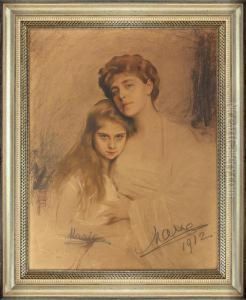Boleslaw Von Szankowsky Paintings
Bolesław von Szankowski, also known as Bolesław Szankowski, was a Polish artist known for his portraiture, genre scenes, and landscapes. Born on October 1, 1893, in Warsaw, which was then part of the Russian Empire, Szankowski grew up in a period of significant political and social upheaval. His interest in art emerged early, and he pursued his education at the School of Fine Arts in Warsaw.
Szankowski's early career was interrupted by World War I, during which he served in the Polish army. After the war, he continued to develop his artistic skills and began to establish himself as a painter. He traveled extensively, which influenced his artistic style and subjects. Szankowski lived and worked in various European cities, including Paris, where he was part of the vibrant artistic community and absorbed influences from the contemporary art movements of the time.
In the 1920s and 1930s, Szankowski gained recognition for his portraiture. He became known for his ability to capture the essence and character of his subjects, which included both prominent figures of the day and private individuals. His portraits are characterized by a sensitive use of color and a focus on the psychological depth of the sitter. Alongside his portraiture, Szankowski also painted genre scenes that often depicted the everyday life of Polish peasants, showcasing his interest in his national heritage and cultural identity.
Throughout his career, Szankowski exhibited his work in various international exhibitions, contributing to his reputation beyond Poland. With the outbreak of World War II, Szankowski's life and career were once again disrupted. The war and its aftermath had a profound impact on the cultural landscape of Europe, and many artists, including Szankowski, faced new challenges in the post-war period.
Bolesław von Szankowski died on November 1, 1953. Although he is not as widely known today as some of his contemporaries, his work remains an important part of Polish art history. His paintings can be found in museums and private collections, where they continue to be appreciated for their beauty and historical significance.
